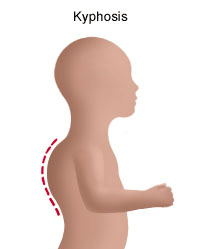Kyphosis

A normal spine appears straight when viewed from behind. However, a spine affected by kyphosis has a forward curvature of the back bones (vertebrae) in the upper back area, giving the child an abnormally rounded or “humpback” appearance.
Kyphosis is defined as a curvature of the spine measuring 50 degrees or greater on an X-ray. The normal spine can bend from 20 degrees to 45 degrees of curvature in the upper back area.
What causes kyphosis?
Kyphosis can be congenital (present at birth), or due to acquired conditions that may include the following metabolic problems, neuromuscular conditions, osteogenesis imperfecta (“brittle bone disease”), spina bifida, Scheuermann’s disease and postural kyphosis. Postural kyphosis is the most common type of kyphosis and it generally becomes noticeable in adolescence with slouching versus a spinal abnormality. Exercise is used to help correct posture.
What are the symptoms of kyphosis?
The following are the most common symptoms of kyphosis. However, each child may experience symptoms differently. Symptoms may include:
- Difference in shoulder height.
- The head bends forward compared to the rest of the body.
- Difference in shoulder blade height or position.
- When bending forward, the height of the upper back appears higher than normal.
- Tight hamstrings (back thigh) muscles.
The symptoms of kyphosis may resemble other spinal conditions or deformities, or may be a result of an injury or infection. Always consult your child’s doctor for a diagnosis.
Early detection of kyphosis is important for successful treatment. Pediatricians or family doctors, and even some school programs, routinely look for signs that kyphosis may be present.
How is kyphosis treated?
The goal of treatment is to stop the progression of the curve and prevent deformity. Treatment may include:
- Observation and repeated examinations. Progression of the curve depends on the amount of skeletal growth, or how skeletally mature, the child is. Curve progression slows down or stops after the child reaches puberty.
- Bracing. If the child is still growing, the doctor may prescribe a brace. The type of brace and the amount of time spent in the brace will be determined by your child’s doctor.
- Surgery. In rare instances, surgery is recommended when the curve measures 75 degrees or more on X-ray and bracing is not successful in slowing down the progression of the curve.
What is the long-term outlook for a child with kyphosis?
Kyphosis will require frequent examinations by your child’s doctor to monitor the curve as your child grows and develops. Early detection is important. If left untreated, kyphosis can lead to problems with lung function.